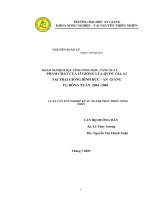metamorphism a2 ian kenyon
Bạn đang xem bản rút gọn của tài liệu. Xem và tải ngay bản đầy đủ của tài liệu tại đây (1.55 MB, 45 trang )
Metamorphism – I.G.Kenyon
Definition
• Meta means ‘change’, Morph means ‘form’
• A change in form of pre-existing rocks of all types.
Sedimentary, igneous and metamorphic
• By the action of Heat alone (Contact)
• By the action of Pressure alone (Dynamic)
• By the action of Heat and Pressure in
combination (Regional)
Metamorphism Excludes:
• Weathering, diagenesis and lithification
• Environments where temperatures are below 200 –
300 degrees centigrade
• Melting Of Rocks - environments where
temperatures are above 650 degrees centigrade
• Environments less than 2km depth and at
pressures below 1000 bars
Metamorphic Grade
• The extent to which the pre-existing rocks have
been changed in form/altered
• Low Grade – slight alteration
• Medium Grade – significant alteration
• High Grade – extensive/total alteration
Metamorphic Changes
• Are assumed to be isochemical
• The bulk chemical composition of the parent rock
and the metamorphic product are identical.
• Both contain the same % Si, Al, O, Na etc.
• The only loss from the system is water as hydrous
clay minerals are dehydrated by a rise in
temperature
Contact Metamorphism
•
•
•
•
Changes due to the action of heat alone
Associated with large scale igneous bodies
Batholiths and plutons of granite/gabbro
Example around the edges of the granites in S.W.
England (St.Austell, Bodmin etc)
• Metamorphic aureole refers to the volume of rock
affected by heat from the intrusion
Controlling Factors - Contact
• Size and shape of the igneous body
• Composition – Acid magma 800 degrees
centigrade, basic magma 1200 degrees
• Thermal conductivity of the country rocks
• Volatile content of the magma
• Distance from edge of igneous body of any
location in the country rocks
The Metamorphic Aureole
• The total volume of older ‘country rocks’ affected
by heat from the intrusion
• Grade of metamorphism decreases from the
intrusion towards the edge of the aureole
• By convention aureoles need to be over 50 metres
wide to be marked on 1:50,000 scale BGS maps
Contact Metamorphism Of
Argillaceous Rocks
• Argillaceous rocks which have undergone
metamorphism are referred to as Pelites
• Low Grade – Spotted Rock
• Medium Grade – Chiastolite Rock
• High Grade – Hornfels
• Argillaceous rocks undergo most change as they
are composed of chemically complex clay
minerals such as kaolinite, illite, smectite,
bentonite and montmorillianite.
Low Grade – Spotted Rock
• Increased temperature to 300 – 400 degrees
centigrade.
• Partial recrystallization occurs
• New minerals occur as oval spots 2 – 5mm in
diameter. Cordierite or iron oxides
• Spots show sieve or poikiloblastic texture Spots have
overgrown and included grains of the original
argillaceous rock
• Relic structures such as bedding/lamination and
fossils may be evident
Spotted Rock - Chapel Porth , Cornwall
Spots 1-3mm in diameter, oval in shape,
greenish colour and composed of cordierite
Laminations - relic structure of
sedimentary rock, therefore low grade
Matrix/groundmass is fine
grained/argillaceous and appears
sedimentary in nature
Spots show sieve or
poikiloblastic texture
Spots concentrated along old lamination
surfaces, sloping left to right in photograph
Red/brown staining due to
oxidation of iron compounds
following chemical weathering
Medium Grade – Chiastolite Rock
• Increase in temperature to 400 – 500 degrees
centigrade, results in coarser grained rock
• Extensive recrystallization occurs
• Needles of chiastolite develop and show
porphyroblastic texture. Up to 2cm long, 3mm in
diameter, square cross section often with iron
inclusions. Groundmass is mainly micas
• Needles show random orientation, having
crystallised in the absence of pressure
• No relic structures are evident
Chiastolite Rock/Chiastolite Hornfels
No evidence of former
sedimentary structure remain
Needles show random orientation, having
crystallised in the absence of directed stress
Porphyroblastic
texture
Needles have
square cross
sections, often
with iron
inclusions
White chiastolite needles Groundmass is very fine
Shows crystalline rather
up to 2cm in length
grained but crystalline
than clastic texture
High Grade - Hornfels
• Increase in temperature 500–600 degrees
centigrade, results in grain size >2mm
• Hornfels shows hornfelsic texture-a tough, fibrous
and splintery-looking rock with a crystalline
texture
• Andalusite often occurs as porphyroblasts
• No evidence of any relic structures
Hornfels/Killas-Cornwall
Formed from argillaceos parent
material: clay/shale/mudstone
Medium to coarse
grained 1-2mm
Crystalline texture
Tough, splintery
hornfelsic texture
No evidence of former
sedimentary structures
Formed adjacent to a
major igneous intrusion
Andalusite Hornfels - Brittany
Tough, compact and
splintery hornfelsic texture
Formed from argillaceous parent
rocks: clay/shale/mudstone
Andalusite needles up to 3cm
long x 5mm across
Porphyroblastic
texture
Andalusite porphyroblasts
show random orientation
indicating crystallisation in
the absence of directed stress
Crystalline groundmass
dark grey in colour
High grade contact or
thermal metamorphism
Andalusite is stable under
high temperatures but
relatively low pressures
3 cm
All evidence of sedimentary
structures destroyed
Contact Metamorphism Of Limestones 1
• Limestones, including chalk are chemically simple
rocks, comprising just calcium carbonate in the
form of the mineral calcite.
• No new can minerals form as there are only atoms
of Ca, C and O present, instead calcium carbonate
recrystallises in a coarser form
• Grain size increases with grade. Low grade
<1mm, Medium 1-2mm, High >2mm
Contact Metamorphism Of Limestones 2
• Limestones recrystallise to form marble
• All fossil detail and older structures are lost during
recrystallisation
• Marbles show granoblastic texture, where all the
crystals are roughly the same size. This is the
metamorphic equivalent of granular texture in
igneous rocks.
Marble – Italy
No evidence of foliation, therefore
formed by contact metamorphism
Calcite crystals are hexagonal with
120 degree triple point junctions
Contact/thermal
metamorphism of a pure
limestone, hence white colour
Crystalline texture
Entirely composed of
recrystallised calcium carbonate
White, sugary saccharoidal or
granoblastic texture
Crystal size 1 – 2mm
medium grade
No evidence of old
sedimentary structures,
therefore at least
medium grade
2 cm
Monomineralic rock-reacts with
dilute hydrochloric acid and can
be scratched easily with steel
Contact Metamorphism Of Limestones 3
• Pure limestones produce white marbles with a
sugary or saccharoidal texture
• Crystals show triple point junctions with 120 degree
angles between adjacent crystals. Indicates
crystallization in the absence of directed stress
• Marbles can be distinguished from metaquartzites
by testing with dilute acid and scratching with a
steel nail
• Marble reacts or fizzes (carbon dioxide is given off)
and is scratched by the steel nail
Contact Metamorphism Of Sandstones 1
• Sandstones are chemically simple rocks
comprising mainly quartz (silicon dioxide)
• No new minerals form from pure sandstones as
there are only atoms of Si and O present. Instead,
quartz recrystallises in a coarser form
• Grain size increases with grade. Low grade
<1mm, Medium 1-2mm, High >2mm
Contact Metamorphism Of Sandstones 2
• Sandstones recrystallise to form metaquartzites
• All fossil detail and older structures are lost during
recrystallisation
• Metaquartzites show granoblastic texture, where
all the crystals are roughly the same size. This is
the metamorphic equivalent of granular texture in
igneous rocks.
Contact Metamorphism Of Sandstones 3
• Crystals show triple point junctions with 120
degree angles between adjacent crystals. Indicates
crystallization in the absence of directed stress
• Metaquartzites can be distinguished from marbles
by testing with dilute acid and scratching with a
steel nail
• Metaquartzite does not react with acid and is not
scratched by a steel nail
Contact Metamorphism Of Sandstone - Metaquartzite
Granoblastic texture, all
crystals 1-2mm in diameter
All evidence of
former sedimentary
structures destroyed
Mineralogy predominantly
grey, glassy, colourless quartz
Recrystallization has resulted in
reduction in porosity
2cm
Crystals show triple point
junctions at 120 degrees
Contact Metamorphism Of Impure
Limestones and Sandstones
• If limestones or sandstones contain an appreciable
clay content, then new minerals will form
• Spots of cordierite and needles of chiastolite and
andalusite (porphyroblasts) will form as the
metamorphic grade increases
• The porphyroblasts will have a random orientation
due to the absence of directed stress at the time of
crystallization









